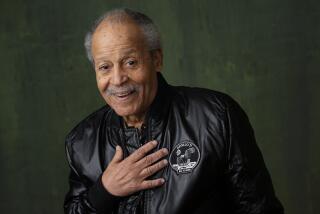Bill Dana dies at 83; NASA test pilot helped usher in space age
The black sky enveloped NASA test pilot Bill Dana as his X-15 rocket plane stopped climbing at 306,900 feet and began teetering back toward the small brown stretch of Mojave Desert more than 58 miles below.
“The horizon appeared as a ring of bright blue around the shell of the earth, with darkness above,” Dana later told NASA officials. “I knew I’d gotten all the altitude I needed to qualify as a space adventurer.”
William Harvey Dana, the famed test pilot who helped usher in the space age in the 1960s by routinely flying rocket planes to new supersonic speeds and stratospheric heights, has died. He was 83.
Dana died Tuesday at an assisted living facility near Phoenix from complications of progressive Parkinson’s disease. His death was announced Wednesday by NASA.
All military pilots are highly skilled, but test pilots have long been considered the best of the best. Like lead climbers who blaze a path up a mountain peak, test pilots help those who follow them avoid costly mistakes.
Dana was a square-jawed aviator during an age when pilots strapped into cutting-edge aircraft and blasted to the edges of the flight envelope — with little assurance they would return safely. It was the era chronicled in “The Right Stuff,” Tom Wolfe’s 1979 book (and later a movie) about the early days of the space program.
Over Dana’s 48-year career, he flew more than 8,000 hours in more than 60 aircraft, including helicopters and wingless experimental rocket planes.
Several of the aircraft Dana piloted now hang in the National Air and Space Museum in Washington, D.C. However, he is perhaps most associated with the X-15 rocket plane program, which demonstrated it was possible for a winged aircraft to fly to — and from — space. It was a feat that came 19 years before the space shuttle.
Dana was born in Pasadena on Nov. 3, 1930, and raised in Bakersfield. He received a bachelor’s degree from the U.S. Military Academy in 1952 and served four years as a pilot in the Air Force.
After earning a master’s degree in aeronautical engineering from USC in 1958, he joined NASA as an aeronautical research engineer at the High-Speed Flight Station — now NASA’s Armstrong Flight Research Center — at Edwards Air Force Base in the Mojave Desert.
A year later, Dana became a research pilot flying an array of aircraft that eventually led to his involvement with the X-15. It had taken about 50 years from the dawn of aviation for engineers to create an aircraft that could break the sound barrier and climb to 80,000 feet.
It took NASA and Inglewood plane manufacturer North American Aviation less than five years to develop and build the X-15, which could fly more than five times the speed of sound and climb to more than 240,000 feet. The program’s many accomplishments were later overshadowed by NASA’s success with the Mercury, Gemini and Apollo programs.
Only 12 men ever flew the X-15, including famed aviators Neil Armstrong and Joe Engle.
“We were as tight of a group as we could be, but we were all busy on other programs, as well,” Engle said. “Bill was one of those types of guys you don’t meet every day. He demanded respect from everyone around him.”
Dana flew the sleek, black aircraft 16 times, reaching a top speed of 3,897 mph and a peak altitude of 306,900 feet. He started flying the aircraft in 1965 and was the last man to fly it in 1968.
Dana was awarded civilian astronaut wings nearly 40 years later for two of his X-15 flights that exceeded altitudes of 50 miles. He didn’t receive that honor earlier because NASA did not give astronaut wings to its pilots.
After the X-15 program, he conducted flight experiments in a wide variety of aircraft, including Northrop’s HL-10 wingless flying wedge aircraft and Martin Marietta’s X-24B, NASA’s last manned rocket plane. The testing Dana did was essential in proving the concept of unpowered approach and landing — a crucial feat in developing the space shuttle.
Testing aircraft also had its lighter moments. In 1969, Dana received a new pressure suit to wear during high-altitude flights in the HL-10. The suit came with white boots instead of the standard black ones.
So Dana asked for a black pair, saying that as a test pilot, he would sooner wear pink boots than white.
When the new boots arrived, they were hot pink with adhesive daisy flower decals on the sides. Not only did he wear the boots on the next flight, he wore them on his last X-24B flight on Sept. 23, 1975.
“Bill was sincere as can be,” said Peter Merlin, an aerospace historian and an author of “X-Plane Crashes,” a book on experimental aircraft. “As an engineer and a pilot, he knew aircraft inside and out.”
Dana served as chief pilot at the Armstrong Flight Research Center from 1986 to 1993, when he was responsible for recruiting, developing and training the next crop of Air Force test pilots.
After stepping down, Dana retired from flying to become the center’s chief engineer. He retired from civil service in May 1998.
Dana earned numerous awards and honors over the years, including the NASA Exceptional Service Medal, the Lancaster Aerospace Walk of Honor and the NASA Distinguished Service Medal.
Dana is survived by his wife, Judi, whom he married in 1962, and four children: Sidney, Matt, Janet and Leslie.
More to Read
Start your day right
Sign up for Essential California for the L.A. Times biggest news, features and recommendations in your inbox six days a week.
You may occasionally receive promotional content from the Los Angeles Times.







